Photobiomodulation-Based Synergic Effects of Pt-Coated TiO2 Nanotubes and 850 nm Near-Infrared Irradiation on the Osseointegration Enhancement: In Vitro and In Vivo Evaluation
Abstract
1. Introduction
2. Materials and Methods
2.1. Preparation and Characterization of Pt-Coated TiO2 NT (Pt-TiO2 NT)
2.2. In Vitro Test
2.2.1. Live-Dead Assay of Human Mesenchymal Stem Cells (hMSCs)
2.2.2. MTT Assay
2.2.3. Alkaline Phosphatase (ALP) Activity Assay
2.2.4. Alizarin Red (AR) Assay
2.3. Animal Study
2.3.1. Production of Experimental Animal Models and Implant Specimens
2.3.2. Experimental Procedure of In Vivo Study
2.3.3. Removal Torque Test
2.3.4. Micro-Computed Tomography (CT) Assessment
2.3.5. Histological Analysis
2.4. Data Analysis
3. Results
4. Discussion
5. Conclusions
Author Contributions
Funding
Institutional Review Board Statement
Data Availability Statement
Conflicts of Interest
References
- Smeets, R.; Stadlinger, B.; Schwarz, F.; Beck-Broichsitter, B.; Jung, O.; Precht, C.; Kloss, F.; Grobe, A.; Heiland, M.; Ebker, T. Impact of Dental Implant Surface Modifications on Osseointegration. Biomed. Res. Int. 2016, 2016, 6285620. [Google Scholar] [CrossRef] [PubMed]
- Jemat, A.; Ghazali, M.J.; Razali, M.; Otsuka, Y. Surface Modifications and Their Effects on Titanium Dental Implants. Biomed. Res. Int. 2015, 2015, 791725. [Google Scholar] [CrossRef]
- Bowler, D.; Dym, H. Bone morphogenic protein: Application in implant dentistry. Dent. Clin. N. Am. 2015, 59, 493–503. [Google Scholar] [CrossRef]
- Yoo, D.; Tovar, N.; Jimbo, R.; Marin, C.; Anchieta, R.B.; Machado, L.S.; Montclare, J.; Guastaldi, F.P.; Janal, M.N.; Coelho, P.G. Increased osseointegration effect of bone morphogenetic protein 2 on dental implants: An in vivo study. J. Biomed. Mater. Res. A 2014, 102, 1921–1927. [Google Scholar] [CrossRef]
- Al-Hezaimi, K.; Nevins, M.; Kim, S.W.; Fateh, A.; Kim, D.M. Efficacy of growth factor in promoting early osseointegration. J. Oral. Implant. 2014, 40, 543–548. [Google Scholar] [CrossRef] [PubMed]
- Keceli, H.G.; Bayram, C.; Celik, E.; Ercan, N.; Demirbilek, M.; Nohutcu, R.M. Dual delivery of platelet-derived growth factor and bone morphogenetic factor-6 on titanium surface to enhance the early period of implant osseointegration. J. Periodontal. Res. 2020, 55, 694–704. [Google Scholar] [CrossRef] [PubMed]
- Choe, R.; Balhaddad, A.A.; Fisher, J.P.; Melo, M.A.S.; Huang, H.C. Photodynamic Therapy for Biomodulation and Disinfection in Implant Dentistry: Is It Feasible and Effective? Photochem. Photobiol. 2021, 97, 916–929. [Google Scholar] [CrossRef]
- Ogawa, T. Ultraviolet photofunctionalization of titanium implants. Int. J. Oral. Maxillofac. Implant. 2014, 29, e95–e102. [Google Scholar] [CrossRef]
- Flanagan, D. Photofunctionalization of Dental Implants. J. Oral. Implant. 2016, 42, 445–450. [Google Scholar] [CrossRef]
- Dini, C.; Nagay, B.E.; Magno, M.B.; Maia, L.C.; Barao, V.A.R. Photofunctionalization as a suitable approach to improve the osseointegration of implants in animal models-A systematic review and meta-analysis. Clin. Oral. Implant. Res. 2020, 31, 785–802. [Google Scholar] [CrossRef]
- Glass, G.E. Photobiomodulation: The Clinical Applications of Low-Level Light Therapy. Aesthet. Surg. J. 2021, 41, 723–738. [Google Scholar] [CrossRef]
- Kuffler, D.P. Photobiomodulation in promoting wound healing: A review. Regen. Med. 2016, 11, 107–122. [Google Scholar] [CrossRef]
- Dima, R.; Tieppo Francio, V.; Towery, C.; Davani, S. Review of Literature on Low-level Laser Therapy Benefits for Nonpharmacological Pain Control in Chronic Pain and Osteoarthritis. Altern. Health Med. 2018, 24, 8–10. [Google Scholar]
- Mansouri, V.; Arjmand, B.; Rezaei Tavirani, M.; Razzaghi, M.; Rostami-Nejad, M.; Hamdieh, M. Evaluation of Efficacy of Low-Level Laser Therapy. J. Lasers. Med. Sci. 2020, 11, 369–380. [Google Scholar] [CrossRef]
- Arjmand, B.; Khodadost, M.; Jahani Sherafat, S.; Rezaei Tavirani, M.; Ahmadi, N.; Hamzeloo Moghadam, M.; Okhovatian, F.; Rezaei Tavirani, S.; Rostami-Nejad, M. Low-Level Laser Therapy: Potential and Complications. J. Lasers. Med. Sci. 2021, 12, e42. [Google Scholar] [CrossRef] [PubMed]
- MF, D.E.O.; Johnson, D.S.; Demchak, T.; Tomazoni, S.S.; Leal-Junior, E.C. Low-intensity LASER and LED (photobiomodulation therapy) for pain control of the most common musculoskeletal conditions. Eur. J. Phys. Rehabil. Med. 2022, 58, 282–289. [Google Scholar]
- Heiskanen, V.; Hamblin, M.R. Photobiomodulation: Lasers vs. light emitting diodes? Photochem. Photobiol. Sci. 2018, 17, 1003–1017. [Google Scholar] [CrossRef] [PubMed]
- Sgolastra, F.; Petrucci, A.; Severino, M.; Gatto, R.; Monaco, A. Lasers for the treatment of dentin hypersensitivity: A meta-analysis. J. Dent. Res. 2013, 92, 492–499. [Google Scholar] [CrossRef]
- Arany, P.R. Craniofacial Wound Healing with Photobiomodulation Therapy: New Insights and Current Challenges. J. Dent. Res. 2016, 95, 977–984. [Google Scholar] [CrossRef]
- Kalhori, K.A.M.; Vahdatinia, F.; Jamalpour, M.R.; Vescovi, P.; Fornaini, C.; Merigo, E.; Fekrazad, R. Photobiomodulation in Oral Medicine. Photobiomodul. Photomed. Laser. Surg. 2019, 37, 837–861. [Google Scholar] [CrossRef]
- Bensadoun, R.J. Photobiomodulation or low-level laser therapy in the management of cancer therapy-induced mucositis, dermatitis and lymphedema. Curr. Opin. Oncol. 2018, 30, 226–232. [Google Scholar] [CrossRef] [PubMed]
- Blay, A.; Blay, C.C.; Tunchel, S.; Gehrke, S.A.; Shibli, J.A.; Groth, E.B.; Zezell, D.M. Effects of a Low-Intensity Laser on Dental Implant Osseointegration: Removal Torque and Resonance Frequency Analysis in Rabbits. J. Oral. Implant. 2016, 42, 316–320. [Google Scholar] [CrossRef] [PubMed]
- Massotti, F.P.; Gomes, F.V.; Mayer, L.; de Oliveira, M.G.; Baraldi, C.E.; Ponzoni, D.; Puricelli, E. Histomorphometric assessment of the influence of low-level laser therapy on peri-implant tissue healing in the rabbit mandible. Photomed. Laser. Surg. 2015, 33, 123–128. [Google Scholar] [CrossRef] [PubMed]
- Mayer, L.; Gomes, F.V.; Carlsson, L.; Gerhardt-Oliveira, M. Histologic and Resonance Frequency Analysis of Peri-Implant Bone Healing After Low-Level Laser Therapy: An In Vivo Study. Int. J. Oral. Maxillofac. Implant. 2015, 30, 1028–1035. [Google Scholar] [CrossRef]
- Mayer, L.; Gomes, F.V.; de Oliveira, M.G.; de Moraes, J.F.; Carlsson, L. Peri-implant osseointegration after low-level laser therapy: Micro-computed tomography and resonance frequency analysis in an animal model. Lasers. Med. Sci. 2016, 31, 1789–1795. [Google Scholar] [CrossRef] [PubMed]
- Kim, Y.D.; Kim, S.S.; Hwang, D.S.; Kim, S.G.; Kwon, Y.H.; Shin, S.H.; Kim, U.K.; Kim, J.R.; Chung, I.K. Effect of low-level laser treatment after installation of dental titanium implant-immunohistochemical study of RANKL, RANK, OPG: An experimental study in rats. Lasers. Surg. Med. 2007, 39, 441–450. [Google Scholar] [CrossRef]
- Moon, K.S.; Park, Y.B.; Bae, J.M.; Choi, E.J.; Oh, S.H. Visible Light-Mediated Sustainable Antibacterial Activity and Osteogenic Functionality of Au and Pt Multi-Coated TiO(2) Nanotubes. Materials 2021, 14, 5976. [Google Scholar] [CrossRef]
- Moon, K.S.; Choi, E.J.; Bae, J.M.; Park, Y.B.; Oh, S. Visible Light-Enhanced Antibacterial and Osteogenic Functionality of Au and Pt Nanoparticles Deposited on TiO(2) Nanotubes. Materials 2020, 13, 3721. [Google Scholar] [CrossRef]
- ISO 10993-5; Biological Evaluation of Medical Devices—Part 5: Tests for In Vitro Cytotoxicity. ISO: Geneva, Switzerland, 2009.
- Lopes, C.B.; Pinheiro, A.L.; Sathaiah, S.; Duarte, J.; Cristinamartins, M. Infrared laser light reduces loading time of dental implants: A Raman spectroscopic study. Photomed. Laser. Surg. 2005, 23, 27–31. [Google Scholar] [CrossRef]
- Gokmenoglu, C.; Ozmeric, N.; Erguder, I.; Elgun, S. The effect of light-emitting diode photobiomodulation on implant stability and biochemical markers in peri-implant crevicular fluid. Photomed. Laser. Surg. 2014, 32, 138–145. [Google Scholar] [CrossRef]
- Mylona, V.; Anagnostaki, E.; Chiniforush, N.; Barikani, H.; Lynch, E.; Grootveld, M. Photobiomodulation effects on periodontal ligament stem cells: A systematic review of in-vitro studies. Curr. Stem. Cell. Res. 2022, 17. [Google Scholar] [CrossRef] [PubMed]
- Chen, Y.S.; Frey, W.; Kim, S.; Homan, K.; Kruizinga, P.; Sokolov, K.; Emelianov, S. Enhanced thermal stability of silica-coated gold nanorods for photoacoustic imaging and image-guided therapy. Opt. Express. 2010, 18, 8867–8878. [Google Scholar] [CrossRef]
- Khlebtsov, B.N.; Khlebtsov, N.G. Multipole plasmons in metal nanorods: Scaling properties and dependence on particle size, shape, orientation, and dielectric environment. J. Phys. Chem. C 2007, 111, 11516–11527. [Google Scholar] [CrossRef]
- Liao, Q.; Mu, C.; Xu, D.S.; Ai, X.C.; Yao, J.N.; Zhang, J.P. Gold Nanorod Arrays with Good Reproducibility for High-Performance Surface-Enhanced Raman Scattering. Langmuir 2009, 25, 4708–4714. [Google Scholar] [CrossRef] [PubMed]
- Zhang, K.; Xiang, Y.; Wu, X.; Feng, L.; He, W.; Liu, J.; Zhou, W.; Xie, S. Enhanced optical responses of Au@Pd core/shell nanobars. Langmuir 2009, 25, 1162–1168. [Google Scholar] [CrossRef] [PubMed]
- Pagano, S.; Lombardo, G.; Caponi, S.; Costanzi, E.; Di Michele, A.; Bruscoli, S.; Xhimitiku, I.; Coniglio, M.; Valenti, C.; Mattarelli, M.; et al. Bio-mechanical characterization of a CAD/CAM PMMA resin for digital removable prostheses. Dent. Mater. 2021, 37, e118–e130. [Google Scholar] [CrossRef]
- Huo, S.C.; Yue, B. Approaches to promoting bone marrow mesenchymal stem cell osteogenesis on orthopedic implant surface. World J. Stem. Cells. 2020, 12, 545–561. [Google Scholar] [CrossRef] [PubMed]
- Long, E.G.; Buluk, M.; Gallagher, M.B.; Schneider, J.M.; Brown, J.L. Human mesenchymal stem cell morphology, migration, and differentiation on micro and nano-textured titanium. Bioact. Mater. 2019, 4, 249–255. [Google Scholar] [CrossRef] [PubMed]
- Nesti, M.; Carli, E.; Giaquinto, C.; Rampon, O.; Nastasio, S.; Giuca, M.R. Correlation between viral load, plasma levels of CD4—CD8 T lymphocytes and AIDS-related oral diseases: A multicentre study on 30 HIV+ children in the HAART era. J. Biol. Regul. Homeost. Agents 2012, 26, 527–537. [Google Scholar]

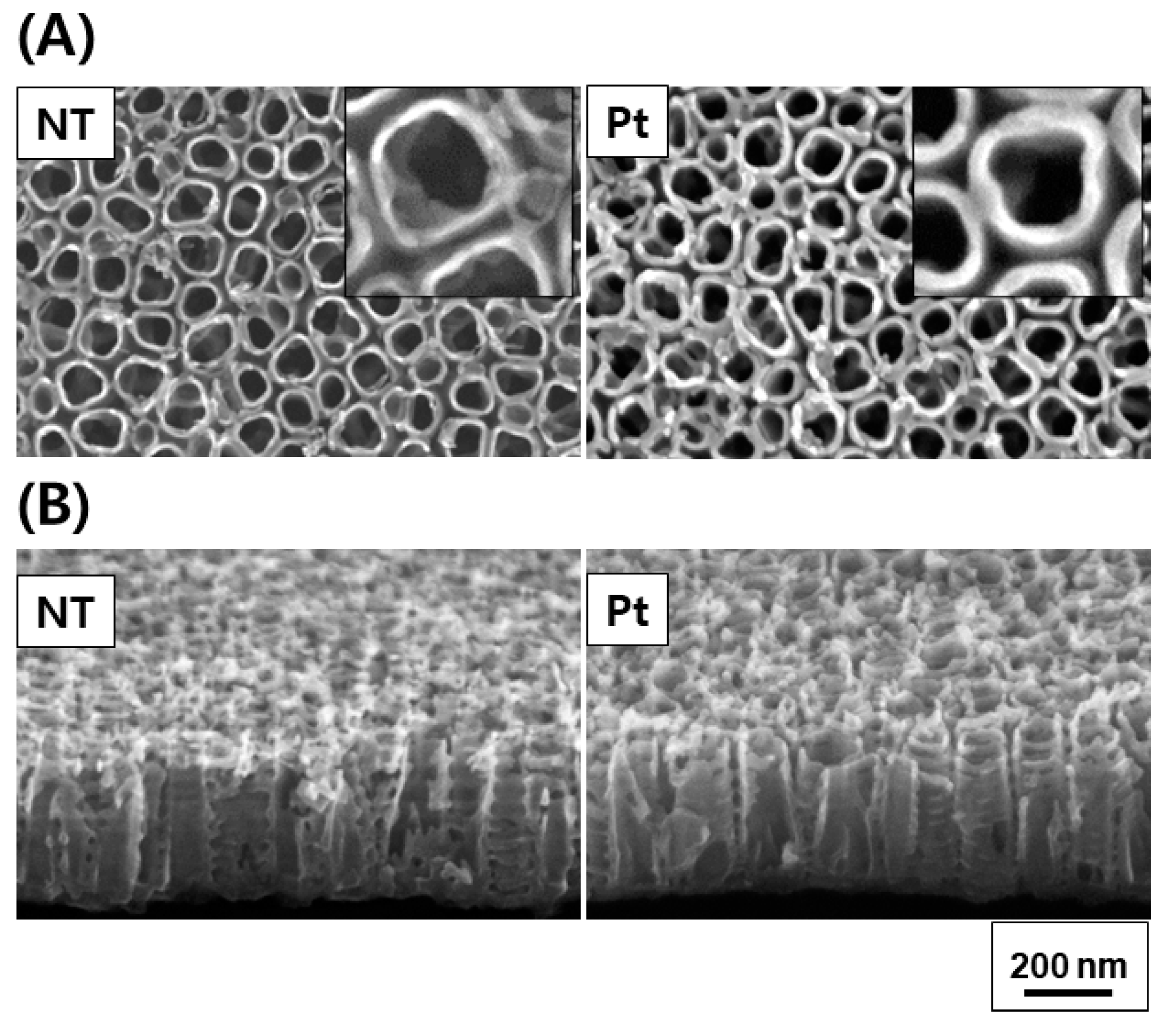
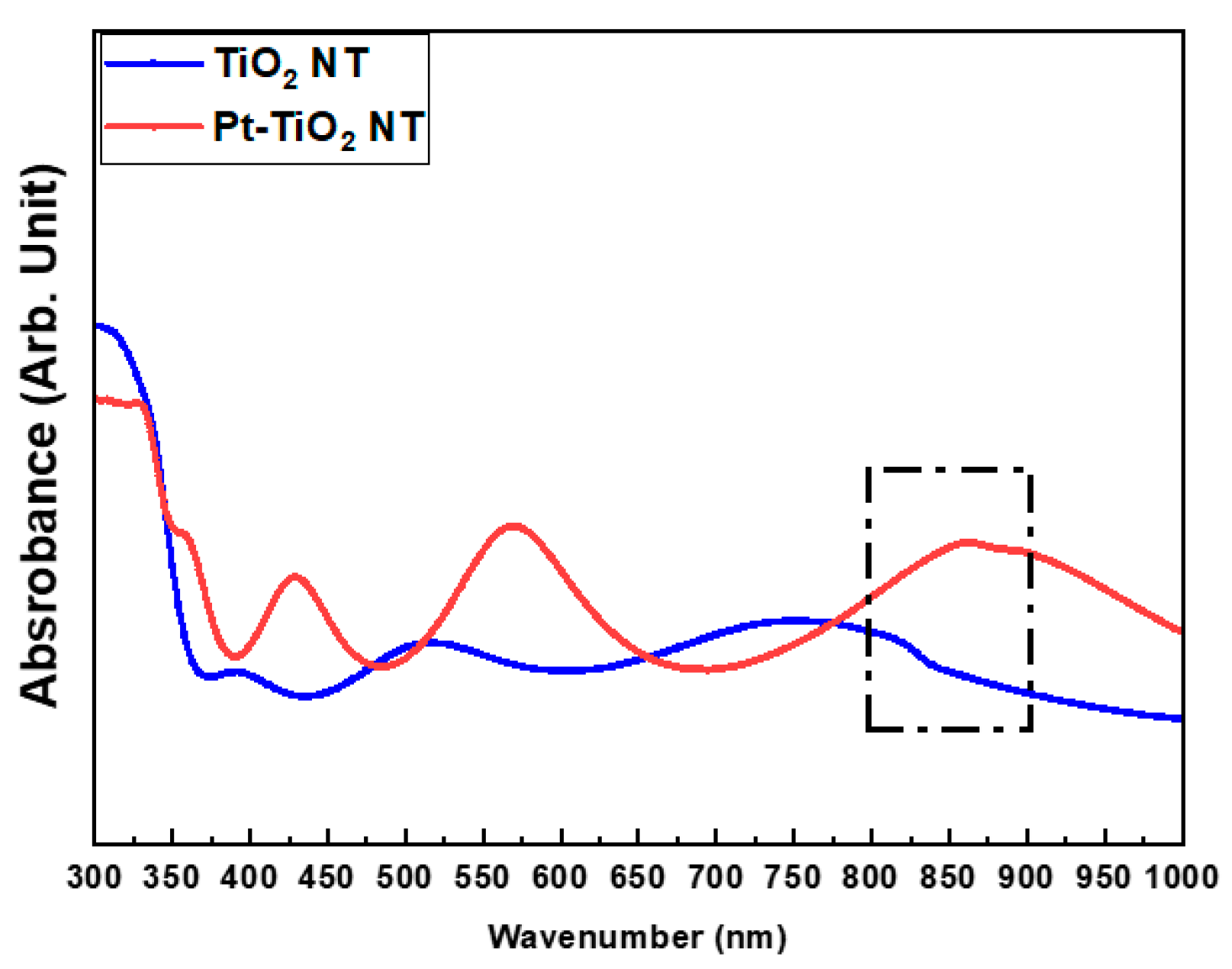
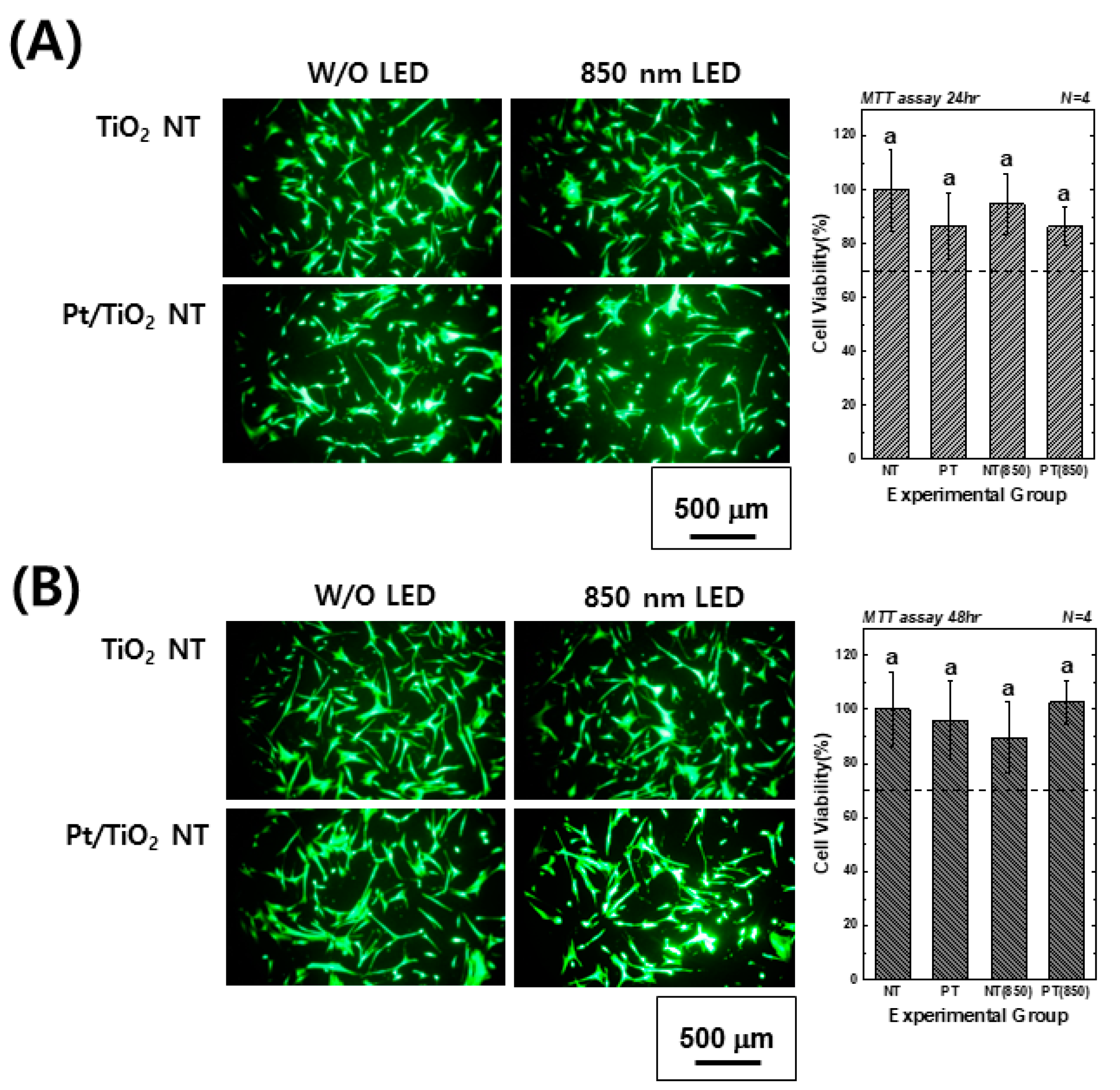

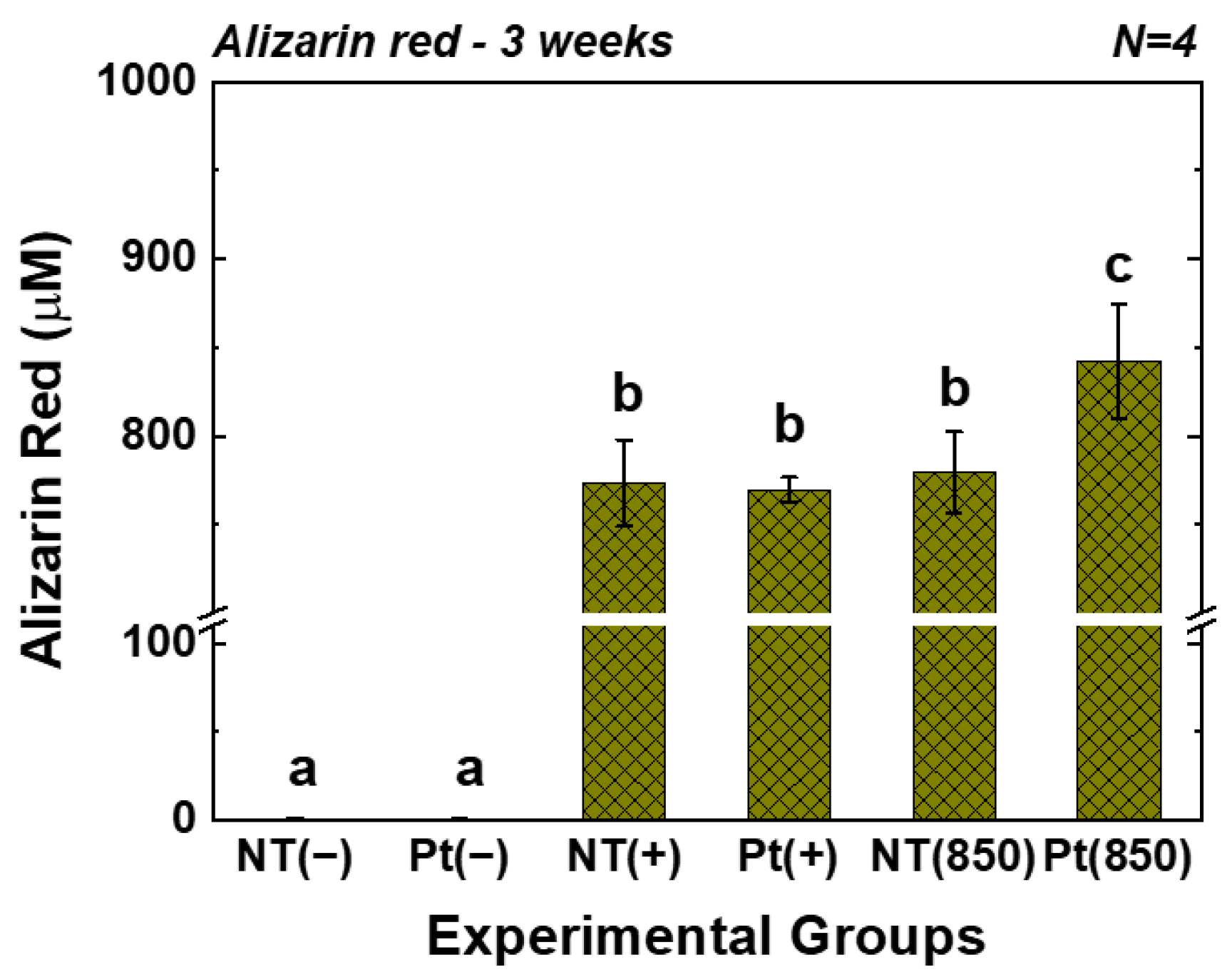
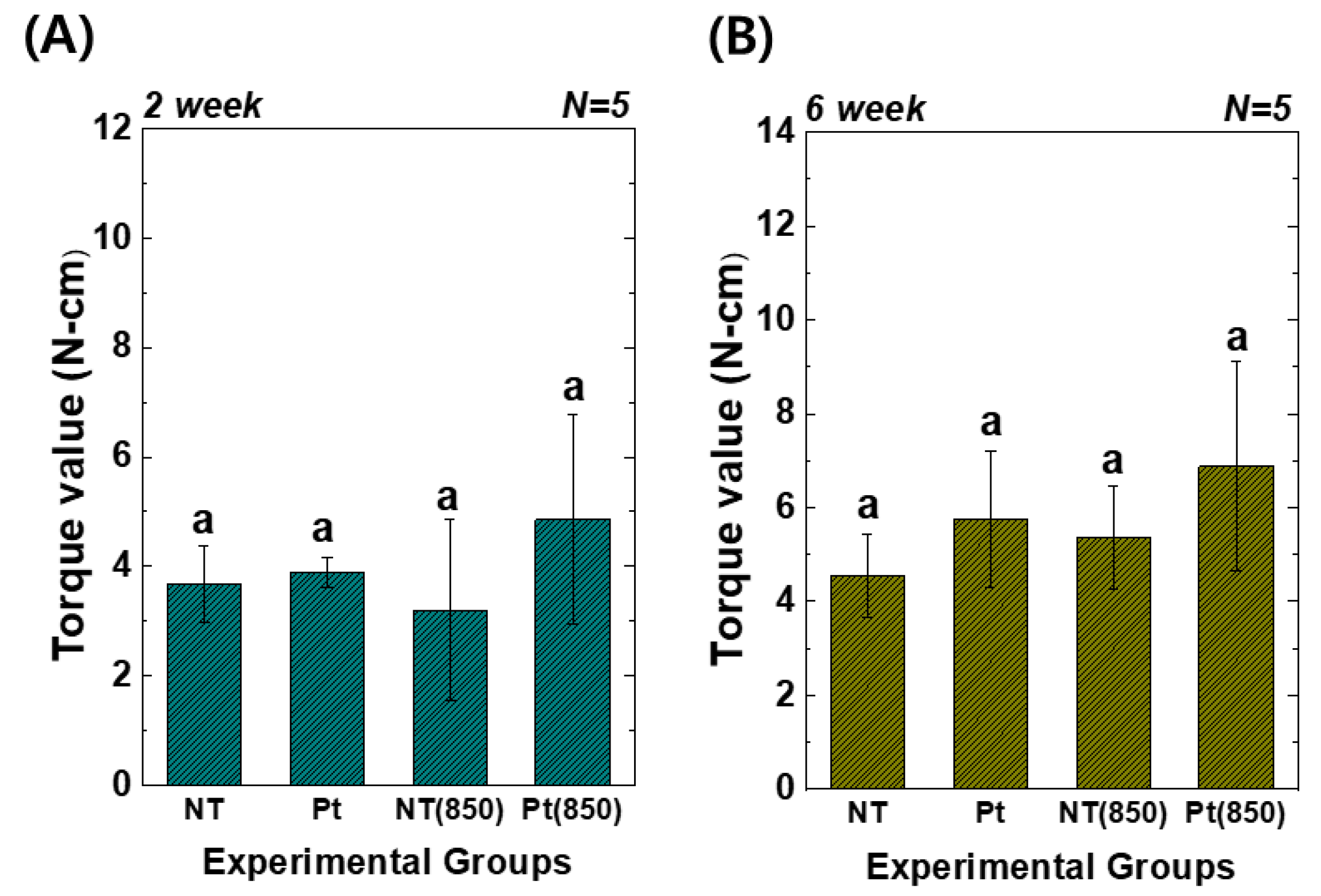

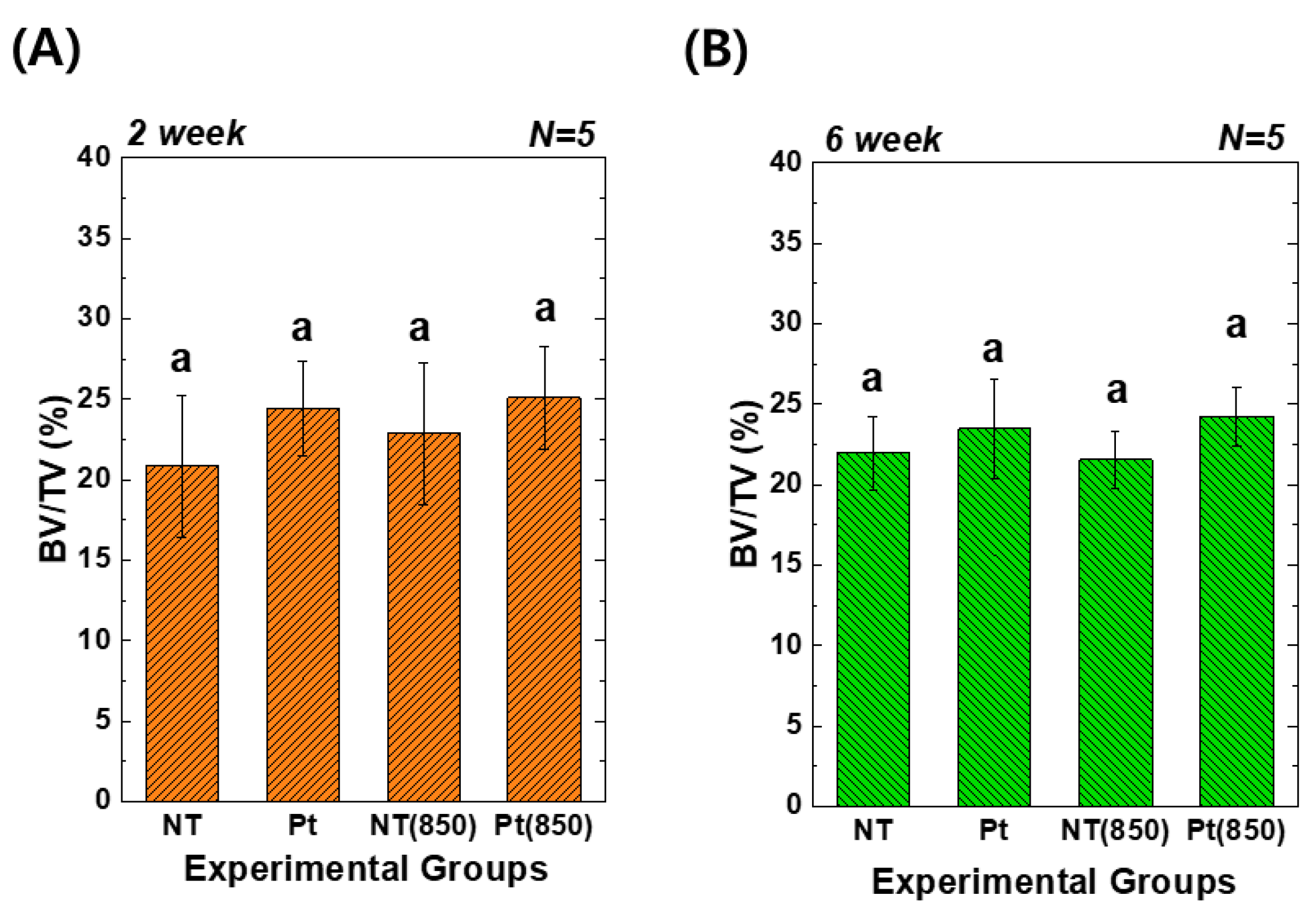
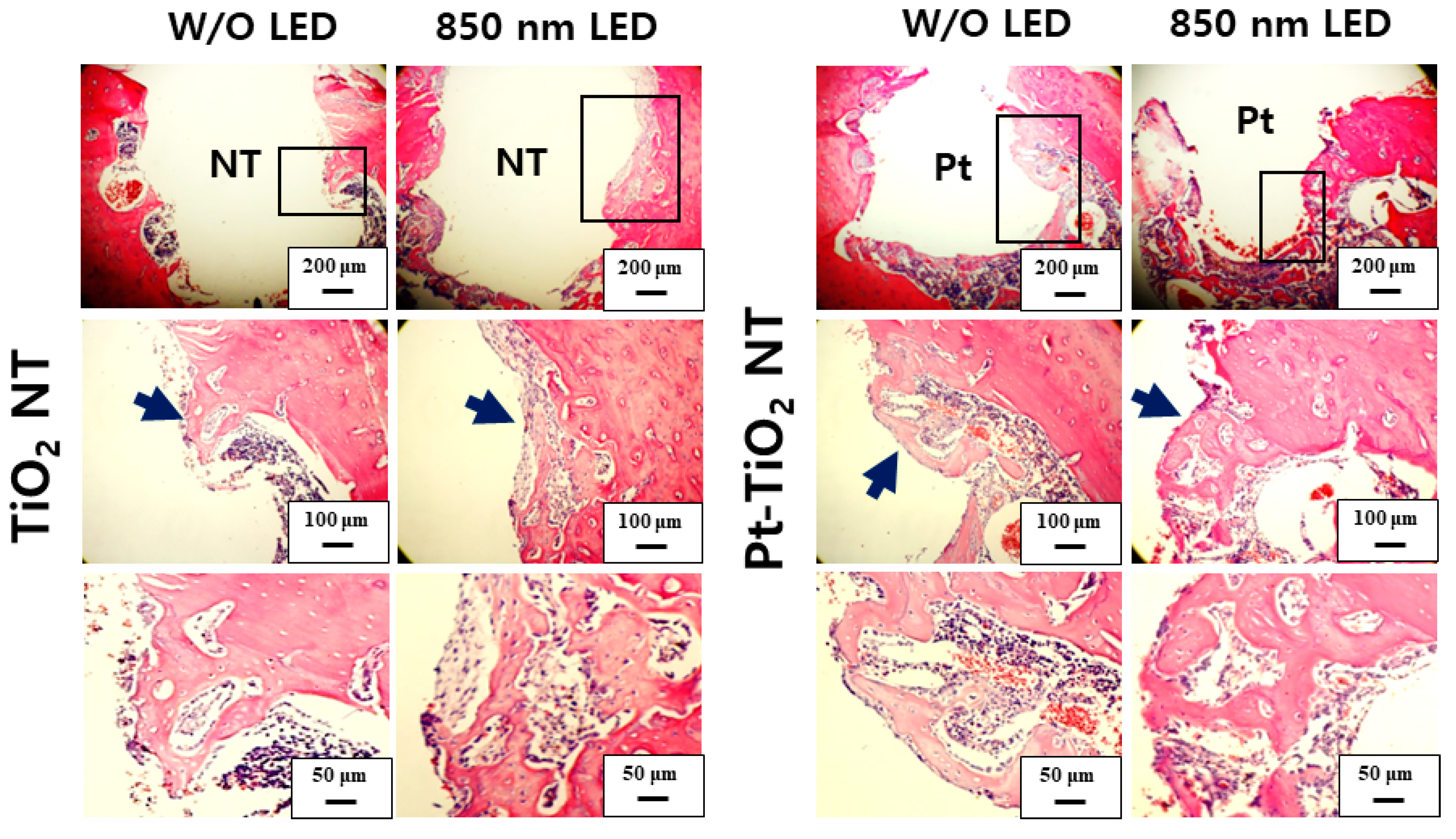

Disclaimer/Publisher’s Note: The statements, opinions and data contained in all publications are solely those of the individual author(s) and contributor(s) and not of MDPI and/or the editor(s). MDPI and/or the editor(s) disclaim responsibility for any injury to people or property resulting from any ideas, methods, instructions or products referred to in the content. |
© 2023 by the authors. Licensee MDPI, Basel, Switzerland. This article is an open access article distributed under the terms and conditions of the Creative Commons Attribution (CC BY) license (https://creativecommons.org/licenses/by/4.0/).
Share and Cite
Moon, K.-S.; Bae, J.-M.; Park, Y.-B.; Choi, E.-J.; Oh, S.-H. Photobiomodulation-Based Synergic Effects of Pt-Coated TiO2 Nanotubes and 850 nm Near-Infrared Irradiation on the Osseointegration Enhancement: In Vitro and In Vivo Evaluation. Nanomaterials 2023, 13, 1377. https://doi.org/10.3390/nano13081377
Moon K-S, Bae J-M, Park Y-B, Choi E-J, Oh S-H. Photobiomodulation-Based Synergic Effects of Pt-Coated TiO2 Nanotubes and 850 nm Near-Infrared Irradiation on the Osseointegration Enhancement: In Vitro and In Vivo Evaluation. Nanomaterials. 2023; 13(8):1377. https://doi.org/10.3390/nano13081377
Chicago/Turabian StyleMoon, Kyoung-Suk, Ji-Myung Bae, Young-Bum Park, Eun-Joo Choi, and Seung-Han Oh. 2023. "Photobiomodulation-Based Synergic Effects of Pt-Coated TiO2 Nanotubes and 850 nm Near-Infrared Irradiation on the Osseointegration Enhancement: In Vitro and In Vivo Evaluation" Nanomaterials 13, no. 8: 1377. https://doi.org/10.3390/nano13081377
APA StyleMoon, K.-S., Bae, J.-M., Park, Y.-B., Choi, E.-J., & Oh, S.-H. (2023). Photobiomodulation-Based Synergic Effects of Pt-Coated TiO2 Nanotubes and 850 nm Near-Infrared Irradiation on the Osseointegration Enhancement: In Vitro and In Vivo Evaluation. Nanomaterials, 13(8), 1377. https://doi.org/10.3390/nano13081377







